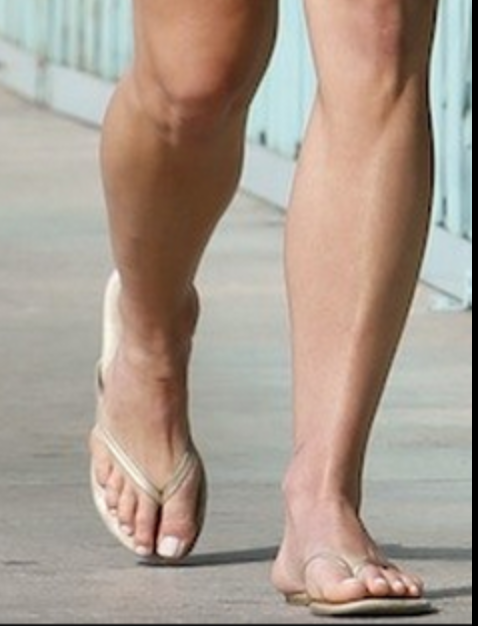More on the scourge of Flip Flops. Riding the inside edge of the sandal. Mystery hunting with Dr. Allen.
/Tis the season upon us. Riding the inside edge of the sandal.
You can see it in the photo, the heel is a third of the way off the sandal.
You either have it or have seen it. It is frustrating as hell if you have it. Your heel rides on only half of your flip flop or summer sandals. You do not notice it in shoes, only in sandals, typically ones without a back or back strap. This is because the heel has no controlling factors to keep it confined on the rear of the sandal sole. There is no heel counter on open backed shoes and sandals, the counter keeps the heel central on the back of the footwear. There is a reason this inside edge riding happens to some, but not everyone. It is best you read on, this isn’t as simple as it might seem.
These clients may have restricted ankle rocker (dorsiflexion), restricted hip extension and/or adductor twist (if your reference is the direction the heel is moving towards). I could even make a biomechanical case that a hallux limitus could result in the same scenario. So what happens is that as the heel lifts and adducts it does not rise directly vertically off the sandal, it spins off medially from the “adductor twist” event. This event is largely from a torque effect on the limb from the impaired sagittal mechanics as described above, manifesting at the moment of premature heel rise resulting in an slightly externally rotating limb (adducting heel). The sandal eventually departs the ground after the heel has risen, but the sandal will rise posturing slightly more laterally ( you can clearly see this on the swing leg foot in the air, the sandal remains laterally postured). Thus, on the very next step, the sandal is not entirely reoriented with its rear foot under the heel, and the event repeats itself. The sandal is slightly more lateral at the rear foot, but to the wearer, we believe it is our heel that is more medial because that is the way it appears on the rear of the sandal or flip flop. Optical illusion, kind of… . . a resultant biomechanical illusion is more like it.
You will also see this one all over the map during the winter months in teenagers who swear by their Uggs and other similar footwear, as you can see in the 2nd photo above. This is not an Ugg or flip flop problem though, this is often a biomechanical foot challenge that is not met by a supportive heel counter and may be a product of excessive rear foot eversion as well. This does not translate to a “stable” enough shoe or boot, that is not what this is about. This is about a rearfoot that moves to its biomechanical happy place as a result of poor or unclean limb and foot biomechanics and because the foot wear does not have a firm stable and controlling heel counter. This is not about too much pronation, so do not make that mistake. And orthotic is not the answer. A heel counter is the answer. The heel counter has several functions, it grabs the heel during heel rise so that the shoe goes with the foot, it give the everting rearfoot/heel something to press against, and as we have suggested today, it helps to keep the rearfoot centered over the shoe platform. To be clear however, the necessary overuse and gripping of the long toe flexors to keep flip flops and backless sandals on our feet during the late stance and swing phases of gait, clearly magnifies these biomechanical aberrations that bring on the “half heel on, half heel off” syndrome.
There you have it. Another solution to a mystery in life that plagues millions of folks.
Shawn Allen, the other gait guy



















